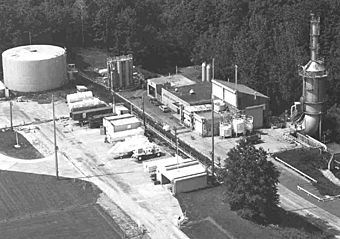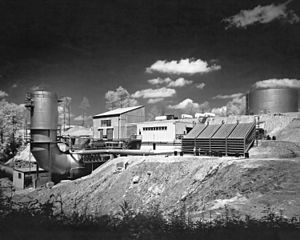Rocket Engine Test Facility facts for kids
|
Rocket Engine Test Facility
|
|
|
Formerly listed on the U.S. National Register of Historic Places
|
|

1982 photograph
|
|
| Lua error in Module:Location_map at line 420: attempt to index field 'wikibase' (a nil value). | |
| Location | Lewis Research Center, Cleveland, Ohio |
|---|---|
| Built | 1957 |
| Architect | National Advisory Committee for Aeronautics (NACA) |
| NRHP reference No. | 85002800 |
Quick facts for kids Significant dates |
|
| Added to NRHP | April 3, 1985 |
| Designated NHL | April 3, 1985 |
| Removed from NRHP | April 4, 2005 |
| Delisted NHL | April 4, 2005 |
The Rocket Engine Test Facility was a special place at NASA's Glenn Research Center in Ohio. It was once known as the Lewis Research Center. Its main job was to test big liquid hydrogen rocket engines. These tests checked how much power (thrust) the engines could make, up to 20,000 pounds!
Engineers from NACA started designing it in 1954. NACA was NASA's earlier version. It cost $2.5 million to build and was finished in 1957. You could find it at the south end of the Center, next to Abrams Creek. Sadly, the facility was taken down in 2003. This was to make space for more runways at the Cleveland Hopkins International Airport.
Contents
What It Could Do
The facility had two main buildings and several smaller support buildings. These buildings helped with the important rocket tests.
Test Stand A
Test Stand A was built for testing rocket engines that stood upright. These engines would fire downwards, and their exhaust gases went into a special scrubber and muffler system. This system cleaned and quieted the exhaust. Test Stand A could handle very powerful engines, testing them at up to 50,000 pounds of thrust.
Test Stand B
Test Stand B was designed by Anthony Fortini and Vearl N. Huff in 1959. However, it wasn't built until after 1980. This stand was different because it tested rocket engines that lay flat. It could also test engines in conditions that were like space! This was done using a special system that cooled the exhaust and created a vacuum. Test Stand B could test engines with up to 1,500 pounds of thrust.
Both Anthony Fortini and Vearl N. Huff received awards for their work on Test Stand B. NASA recognized their important contributions to space technology.
Support Systems
The facility also had many support systems. These included large tanks to store super-cold fuels, like liquid hydrogen. There was also a big water reservoir. Smaller buildings included a control room, called a block house, where engineers could safely watch the tests. There was also a pump house and shelters for special equipment. In 1984, the facility was updated to test even larger rocket nozzles.
A National Historic Landmark
The Rocket Engine Test Facility was named a U.S. National Historic Landmark in 1985. This was because it played a very important part in developing liquid hydrogen as a rocket fuel.
Key Rocket Engines Tested
Many famous rocket engines were tested here, including:
- The Pratt & Whitney RL-10 engine, used for the Centaur upper stage.
- The J-2 engine, which had a huge 200,000 pounds of thrust. This engine powered the second stage of the mighty Saturn V rocket.
- The hydrogen-oxygen engines used by the Space Shuttle.
After the facility was taken down in 2003, it was removed from the National Historic Landmark list on April 4, 2005.
Further Reading
- Dawson, Virginia P. Ideas into hardware: A history of the Rocket Engine Test Facility at the NASA Glenn Research Center. (2004)


